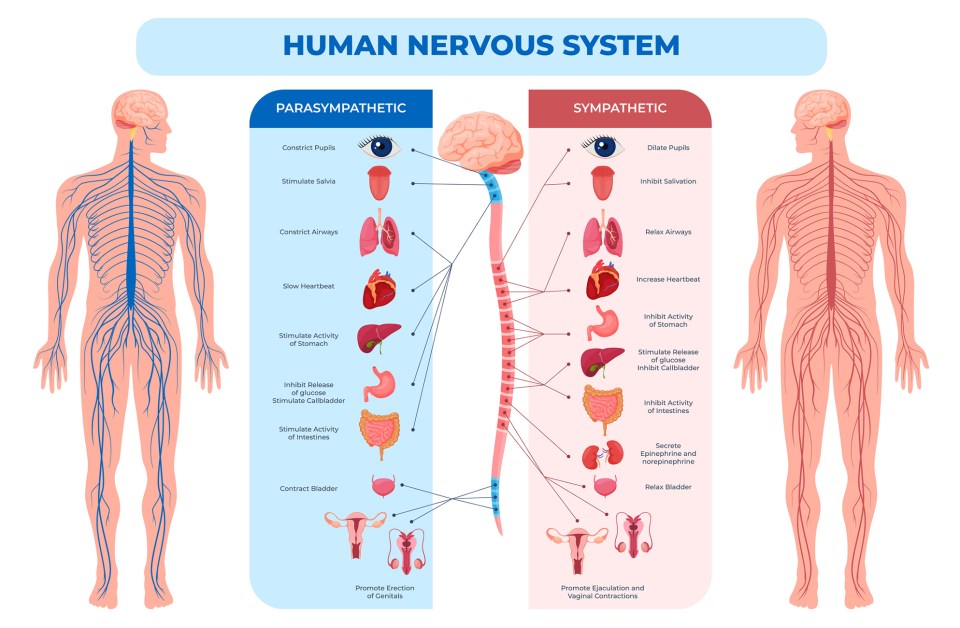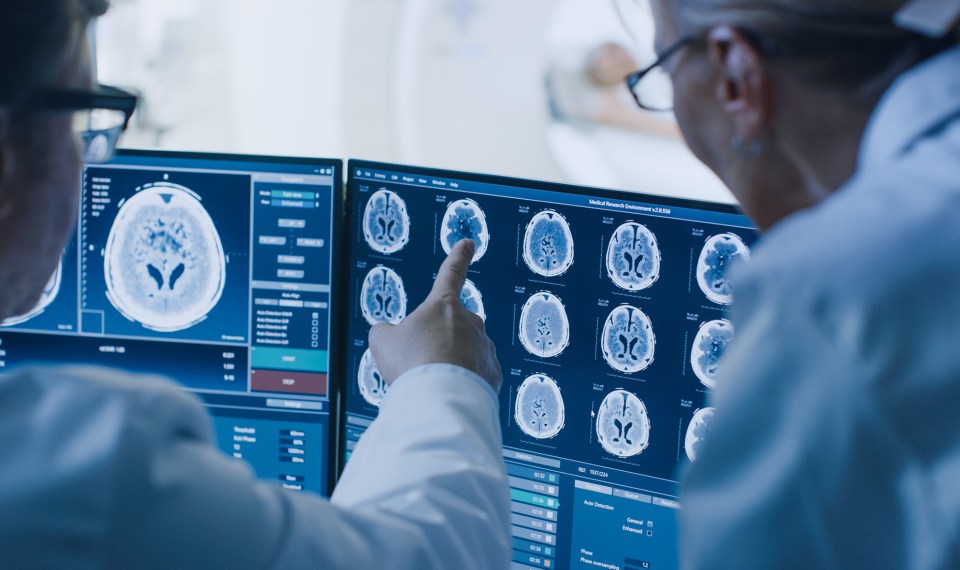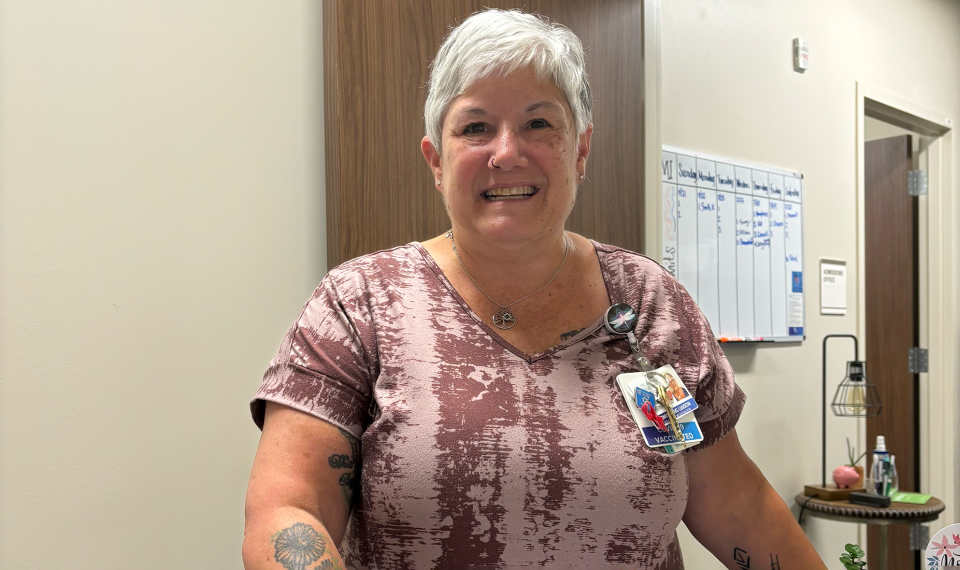The nervous system functions as the command center for the body, regulating body activities. It is made up of two main parts—the central nervous system (CNS) and the peripheral nervous system (PNS). The CNS consists of the brain and spinal cord, while the PNS is made up of the remaining nerves throughout the body including the peripheral nerves and the autonomic nerves.
Nerves, or fibers, carry messages to and from the body and the brain. The nervous system is responsible for various body functions including:
- Basic functions such as heartbeat, breathing and digestion
- Sensory functions including touch, pressure, pain, sight, hearing, taste and smell
- Movement and coordination
- The ability to process information for learning, memory, language, thoughts, emotions and reasoning
There are hundreds of diseases and disorders of the nervous system that impact the way the body functions. Injury, infection, disease, structural defects, blood flow disruptions and cancer can all cause nervous system damage. A few nervous system diseases and disorders are:
Headache
Some experts consider headache the most common neurological disorder. Some headaches are classified as secondary headaches indicating they are due to another condition such as sinusitis, hangover, brain tumor, aneurysm, ear infection, high blood pressure and other various conditions.
Primary headaches are those that have no clear underlying cause and include migraine, migraine with aura, cluster headache, tension headache, and trigeminal autonomic cephalalgia.
- Symptoms of headache include pain that can be sharp, dull or throbbing. The pain may be on one or both sides of the head and may radiate across the head. Headache pain may last for only a short time or persist for days.
- Treatment of headache varies greatly depending on the cause. Prescription or over-the-counter medications, hot or cold compresses and massage may be recommended treatment options for the various types of headaches.

Parkinson’s Disease (PD)
Parkinson’s disease is a progressive disorder that is thought to be caused by a combination of genetic and environmental factors, although the exact cause is not known. Brain cells in the basal ganglia and substantia nigra are affected.
- Parkinson’s symptoms are generally mild in the early stages and include tremor in one hand, rigidity and loss of facial expression on one side. As the disease progresses, both sides of the body are affected. Patients experience loss of balance, blinking slows and rapid involuntary movement occurs. As the disease worsens, patients lose the ability to stand and eventually become incapacitated. In the later stages, some patients experience hallucinations or delusions.
- Treatment options for PD vary depending on the symptoms the patient is experiencing. There is no cure for Parkinson’s and treatment is aimed at symptom management. Lifestyle changes that provide benefit include aerobic exercise, getting plenty of rest, stretching and balance exercises. Physical therapy and speech therapy may also be helpful. Symptoms are usually caused by decreased dopamine levels in the brain, but dopamine cannot be administered directly to the brain, so medications are prescribed to temporarily replace the dopamine or mimic dopamine action. Dosages are personalized to each patient, depending on their specific needs and symptoms. Many of these medications interact with certain foods, other prescription medications and over-the-counter supplements and may need to be administered in various doses throughout the day to control symptoms.
Surgical treatment of Parkinson’s disease is reserved for patients who have exhausted other treatment options. Some surgical interventions used in the past were aimed at destroying specific areas of the brain to control motor symptoms. These surgeries are rarely used today. Current surgical options include deep brain stimulation to disrupt specific brain signals and Duopa therapy surgery. Duopa is a gel form of carbidopa/levodopa that requires surgical insertion of a tube through the patient’s stomach into the intestine. The tube is connected to an external pump that administers the medication.
Research is ongoing for the treatment of Parkinson’s Disease including experimental stem cell therapy.
Multiple sclerosis (MS)
Multiple sclerosis occurs when the body’s own immune system attacks the central nervous system – the brain and spinal cord. Inflammation of the nerve fibers and the myelin sheath (a protective coating that covers the nerves) causes damage, disrupting or blocking signals from the nerves to various parts of the body, which causes the symptoms of MS. The exact cause of multiple sclerosis is unknown, but the chronic disease may be due to a combination of factors including genetics, immune system defects, infections or environmental causes.
Symptoms vary greatly and are not the same for everyone. Patients often experience fluctuations and changes in symptoms, which may come and go for days, weeks or years. MS can affect all areas of the body but common symptoms include:
- Problems walking. Patients may experience weakness, spastic movement, balance problems, sensory loss and fatigue.
- Dysesthesia (MS Hug). Many patients report a squeezing or hugging sensation around the torso as their first symptom.
- Fatigue. Marked fatigue can interfere with daily activities.
- Spasticity. Muscle contracture, stiffness, involuntary movement and spasm is typically experienced in the legs but can happen in the arms, as well.
- Numbness or tingling. Numbness in the face, arms, legs or body is an early symptom.
- Weakness. Damage to nerves and lack of muscle usage can lead to weakness.
- Vision disturbances. MS patients may complain of double vision, eye pain with movement, diminished vision, blurring and partial or complete loss of vision.
- Bowel and bladder problems. Constipation and loss of bowel and bladder control may occur. Patients may also suffer from bladder emptying problems.
- Cognitive changes. Processing information, learning, problem-solving ability and loss of attention may all occur in MS patients.
- Emotional changes and depression. Mood changes, anxiety and difficulty controlling emotional responses are just some of the symptoms seen in multiple sclerosis. Depression is also prevalent.
Treatment of MS is aimed at managing symptoms. Medications such as Interferon, Glatiramer acetate, monoclonal antibodies and chemotherapy drugs may all be helpful in decreasing symptom frequency, lessening exacerbations and treating increasing symptoms. Intravenous glucocorticoids – steroids – may be administered to reduce the severity of new or recurring attacks, followed by a course of steroid pills. Adrenocorticotropic hormone (ACTH) gel and plasmapheresis, a “blood-cleansing procedure,” are additional treatment options. An inpatient rehabilitation program that includes physical, occupational and speech therapies is also beneficial in maintaining or improving function and quality of life.
Guillain-Barre´ Syndrome (GBS)
Guillain-Barre´ is an autoimmune disorder, meaning the body’s own immune system attacks the peripheral nervous system (the nerves outside the brain and spinal cord). Cases range from mild and brief to severe, causing paralysis and the inability to breathe independently. GBS typically occurs after a viral or bacterial infection and occasionally is triggered by surgery. Guillain-Barre is seen in those of all ages and occurs with equal frequency in both men and women. Most patients recover fully from GBS and even those with severe symptoms recover most of their ability.
Symptoms of GBS often start with numbness and tingling in the hands and feet. Weakness is a key symptom and patients may have difficulty walking or climbing steps. Other symptoms include:
- Pain that may be worse at night
- Muscle weakness and unsteadiness
- Swallowing or speaking difficulty
- Difficulty breathing
- Bladder control issues
- Heart rate or blood pressure problems
Treatment of Guillain-Barre involves therapies to lessen the severity of symptoms and speed recovery. Since symptoms can progress rapidly, prompt treatment is required. Two treatment methods are commonly used.
- Intravenous Immunoglobulin Therapy (IVIg) uses proteins the body makes to fight organisms that cause infection. The immunoglobulins are collected from a pool of thousands of donors and administered as an IV infusion to reduce the effects of the immune system attack.
- Plasma Pheresis (plasma exchange) is done by filtering plasma – the liquid portion of the blood—to remove the antibodies that are causing the nerve damage. The clean plasma is then returned to the body.
Guillain-Barre patients are usually transferred from acute care to an inpatient rehabilitation hospital where they receive three hours of therapy a day, five days a week to help them regain strength and resume activities of daily living before returning home.
Stroke or Cerebrovascular Accident (CVA)
Commonly referred to as stroke, CVA occurs when a blood vessel in the brain ruptures (hemorrhagic stroke) or a clot blocks the blood flow to the brain (ischemic stroke). Depending on the part of the brain involved and extent of the damage, neurological complications can occur in different parts of the body. A stroke that happens in the left side of the brain will affect the right side of the body, while a stroke on the brain’s right side will impact the body’s left side. A stroke in the brain stem impacts both sides of the body.
Symptoms of stroke should send patients to the nearest hospital because immediate medical care can help prevent extensive or permanent damage. The acronym, F.A.S.T., is used to identify stroke symptoms.
F – Face Drooping
A – Arm weakness
S – Slurred speech
T – Time to call 911
Other stroke symptoms depending on the area of the brain where the stroke occurred include:
- Paralysis on one or both sides of the body
- Speech/language difficulties
- Vision problems
- Memory loss
- Changes in behavior
Treatment of stroke depends on the type of stroke. Immediate treatment is vital in reducing disability and improving recovery outlook. It is imperative that patients with stroke symptoms seek immediate medical care. Treatment options include:
- Thrombolytic agents, such as tissue plasma activator, or tPA, can be administered to break up the clot, if a patient is treated within the first 3 hours of symptoms
- Blood thinners may be used to treat ischemic stroke
- Surgery to remove the clot in ischemic stroke or to stop the bleeding in hemorrhagic stroke
- Endovascular immobilization is a procedure done under general anesthesia to treat hemorrhagic stroke. A catheter, or tube, is inserted into an artery in the groin allowing the physician to access the point where bleeding occurred. Once the vessel is identified, it is then sealed to stop the bleed
- Stroke rehabilitation begins almost immediately after the condition is stabilized. Therapy is individualized but may include physical, speech and occupational therapy.
- Additional medications and lifestyle modifications may be needed to address health issues and lessen the risk of a second stroke
The above conditions are just a few of the hundreds of neurological disorders. Diagnosis is critical in identifying the disorder and determining the proper treatment.
The content of this site is for informational purposes only and should not be taken as professional medical advice. Always seek the advice of your physician or other qualified healthcare provider with any questions you may have regarding any medical conditions or treatments.



